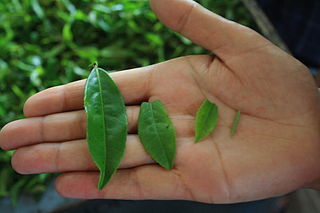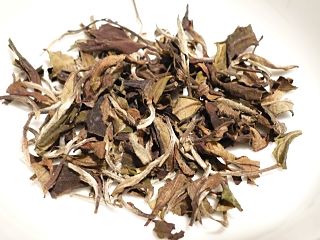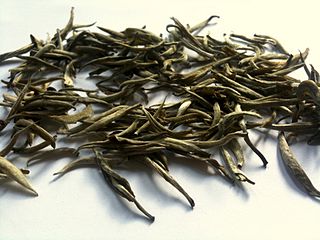
Oolong (,;Chinese:烏龍茶is a traditional semi-oxidized Chinese tea produced through a process that includes withering the leaves under strong sun and allowing some oxidation to occur before curling and twisting. Most oolong teas,especially those of fine quality,involve unique tea plant cultivars that are exclusively used for particular varieties. The degree of oxidation,which is controlled by the length of time between picking and final drying,can range from 8% to 85% depending on the variety and production style. Oolong is especially popular in southeastern China and among ethnic Chinese in Southeast Asia,as is the Fujian preparation process known as the gongfu tea ceremony.

Tea is an aromatic beverage prepared by pouring hot or boiling water over cured or fresh leaves of Camellia sinensis,an evergreen shrub native to East Asia which probably originated in the borderlands of southwestern China and northern Myanmar. Tea is also made,but rarely,from the leaves of Camellia taliensis. After plain water,tea is the most widely consumed drink in the world. There are many different types of tea;some have a cooling,slightly bitter,and astringent flavour,while others have profiles that include sweet,nutty,floral,or grassy notes. Tea has a stimulating effect in humans,primarily due to its caffeine content.

Green tea is a type of tea that is made from Camellia sinensis leaves and buds that have not undergone the same withering and oxidation process which is used to make oolong teas and black teas. Green tea originated in China,and since then its production and manufacture has spread to other countries in East Asia.

Lapsang souchong or Zhengshan xiaozhong is a black tea consisting of Camellia sinensis leaves that may be smoke-dried over a pinewood fire. This smoking is accomplished either as a cold smoke of the raw leaves as they are processed or as a hot smoke of previously processed leaves. The intensity of the smoke aroma can be varied by locating the leaves closer or farther from the source of heat and smoke or by adjusting the duration of the process. The flavour and aroma of smoked lapsang souchong is described as containing empyreumatic notes,including wood smoke,pine resin,smoked paprika,and dried longan;it may be mixed with milk but is not bitter and usually not sweetened with sugar. The tea originates from the Wuyi Mountains region of Fujian and is considered a Wuyi tea. It is also produced in Taiwan. It has been labelled as smoked tea,smoky souchong,tarry lapsang souchong and lapsang souchong crocodile. While the tea leaf grading system adopted the term souchong to refer to a particular leaf position,lapsang souchong may be made with any leaf of the Camellia sinensis plant,though it is not unusual for the lower leaves,which are larger and less flavourful,to be used as the smoking compensates for the lower flavour profile and the higher leaves are more valuable for use in unflavoured or unblended teas. In addition to its consumption as a tea,lapsang souchong is also used in stock for soups,stews and sauces or otherwise as a spice or seasoning. Beginning in the early 21st century,an unsmoked variety of lapsang souchong was developed in the village of Tong Mu Guan in the Wuyi mountains. The unsmoked variety has become increasingly popular,particularly in the Chinese domestic market.

Pu'er or pu-erh is a variety of fermented tea traditionally produced in Yunnan Province,China. In the context of traditional Chinese tea production terminology,fermentation refers to microbial fermentation,and is typically applied after the tea leaves have been sufficiently dried and rolled. As the tea undergoes controlled microbial fermentation,it also continues to oxidize,which is also controlled,until the desired flavors are reached. This process produces tea known as hēichá (黑茶),literally "black tea",though the term is commonly translated to English as "dark tea" to distinguish it from the English-language black tea.

Theaceae,the tea family,is a family of flowering plants comprising shrubs and trees,including the economically important tea plant,and the ornamental camellias. It can be described as having from seven to 40 genera,depending on the source and the method of circumscription used. The family Ternstroemiaceae has been included within Theaceae;however,the APG III system of 2009 places it instead in Pentaphylacaceae. Most but not all species are native to China and East Asia.

In the tea industry,tea leaf grading is the process of evaluating products based on the quality and condition of the tea leaves themselves.

Camellia sinensis is a species of evergreen shrub or small tree in the flowering plant family Theaceae. Its leaves,leaf buds,and stems can be used to produce tea. Common names include tea plant,tea shrub,and tea tree.
Decaffeination is the removal ("de-") of caffeine from coffee beans,cocoa,tea leaves,and other caffeine-containing materials. Decaffeinated products are commonly termed by the abbreviation decaf. Decaffeinated drinks contain typically 1–2% of the original caffeine content,but sometimes as much as 20%.

Assam tea is a black tea named after Assam,India,the region of its production. It is manufactured specifically from the plant Camellia sinensis var. assamica (Masters). The Assam tea plant is indigenous to Assam—initial efforts to plant the Chinese varieties in Assam soil did not succeed. Assam tea is now mostly grown at or near sea level and is known for its body,briskness,malty flavour,and strong,bright colour. Assam teas,or blends containing Assam tea,are often sold as "breakfast" teas. For instance,Irish breakfast tea,a maltier and stronger breakfast tea,consists of small-sized Assam tea leaves.
The history of tea in China is long and complex,for the Chinese have enjoyed tea for millennia. Scholars hailed the brew as a cure for a variety of ailments;the nobility considered the consumption of good tea as a mark of their status,and the common people simply enjoyed its flavour. In 2016,the discovery of the earliest known physical evidence of tea from the mausoleum of Emperor Jing of Han in Xi'an was announced,indicating that tea from the genus Camellia was drunk by Han dynasty emperors as early as the 2nd century BCE. Tea then became a popular drink in the Tang (618–907) and Song (960–1279) dynasties.

Chinese tea generally refers to a variety of teas which are grown or consumed in China.

Bai Mudan is a type of white tea made from plucks each with one leaf shoot and two immediate young leaves of the Camellia sinensis plant. Bai Mudan is sometimes preferred by white tea drinkers for its fuller flavor and greater potency than the other major type of white tea,Bai Hao Yinzhen. The latter is made purely with leaf shoots,and so it is comparatively softer and more subtle. The typical taste of Bai Mudan is a result of both the processing and the tea plant cultivars employed in the production.

Baihao Yinzhen,also known as White Hair Silver Needle,is a white tea produced in Fujian Province in China. Amongst white teas,this is the most expensive variety and the most prized,as only top buds of the Camellia sinensis plant are used to produce the tea. Genuine Silver Needles are made from cultivars of the Da Bai tea tree family. There are other productions that look similar with downy leaf shoots but most are green teas,and as green teas,they taste differently and have a different biochemical potency than the genuine white tea Silver Needle. It is commonly included among China's famous teas.

Darjeeling tea is a tea made from Camellia sinensis var. sinensis that is grown and processed in Darjeeling district or Kalimpong district in West Bengal,India. Since 2004,the term Darjeeling tea has been a registered geographical indication referring to products produced on certain estates within Darjeeling and Kalimpong. The tea leaves are processed as black tea,though some estates have expanded their product offerings to include leaves suitable for making green,white,and oolong teas.

Tea processing is the method in which the leaves from the tea plant Camellia sinensis are transformed into the dried leaves for brewing tea.

Epigallocatechin gallate (EGCG),also known as epigallocatechin-3-gallate,is the ester of epigallocatechin and gallic acid,and is a type of catechin.

The phenolic content in tea refers to the phenols and polyphenols,natural plant compounds which are found in tea. These chemical compounds affect the flavor and mouthfeel of tea. Polyphenols in tea include catechins,theaflavins,tannins,and flavonoids.

Black tea is a type of tea that is more oxidized than oolong,yellow,white and green teas. Black tea is generally stronger in flavour than other teas. All five types are made from leaves of the shrub Camellia sinensis, though Camellia taliensis is also used rarely.

Camellia taliensis is a small species of evergreen shrub whose leaves and leaf buds are used to produce tea.

















